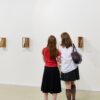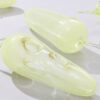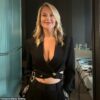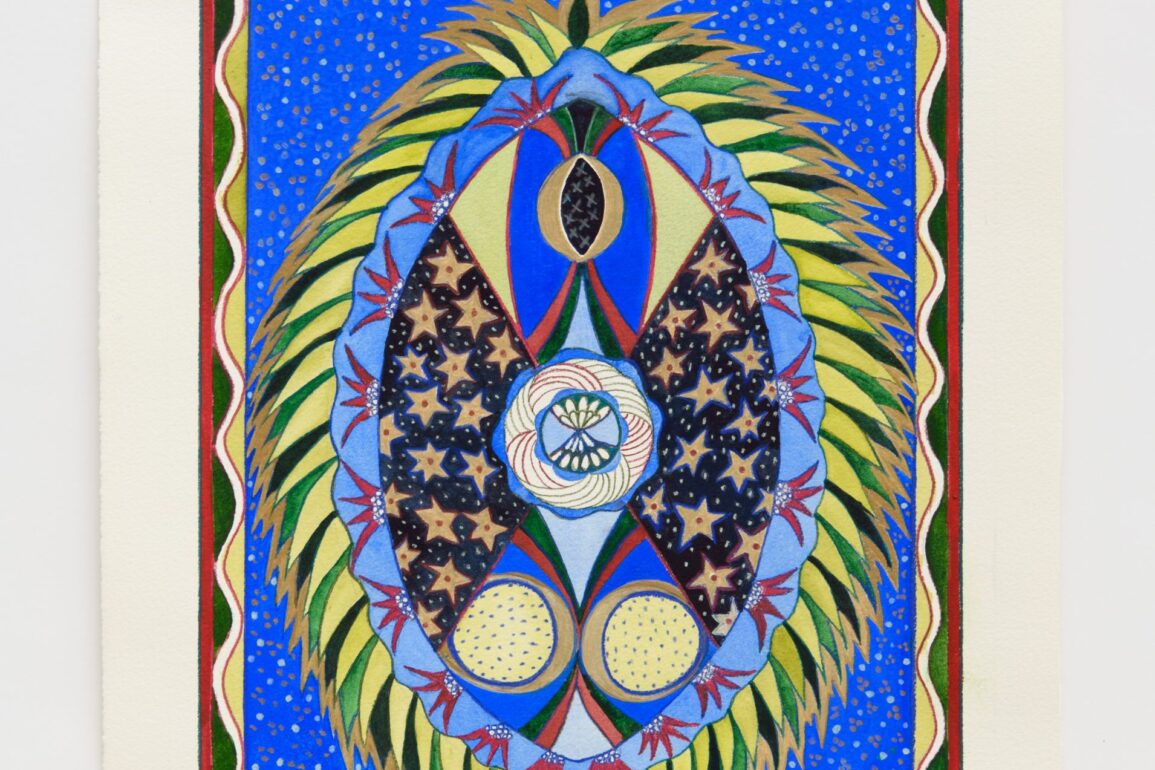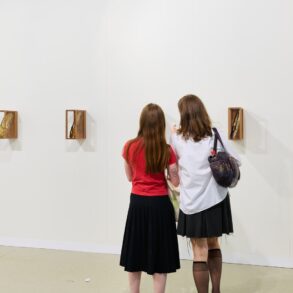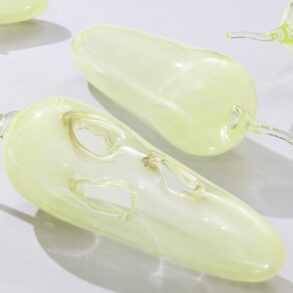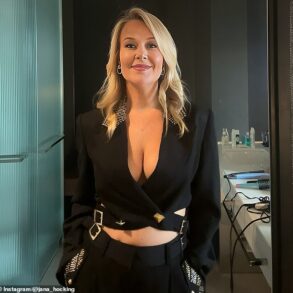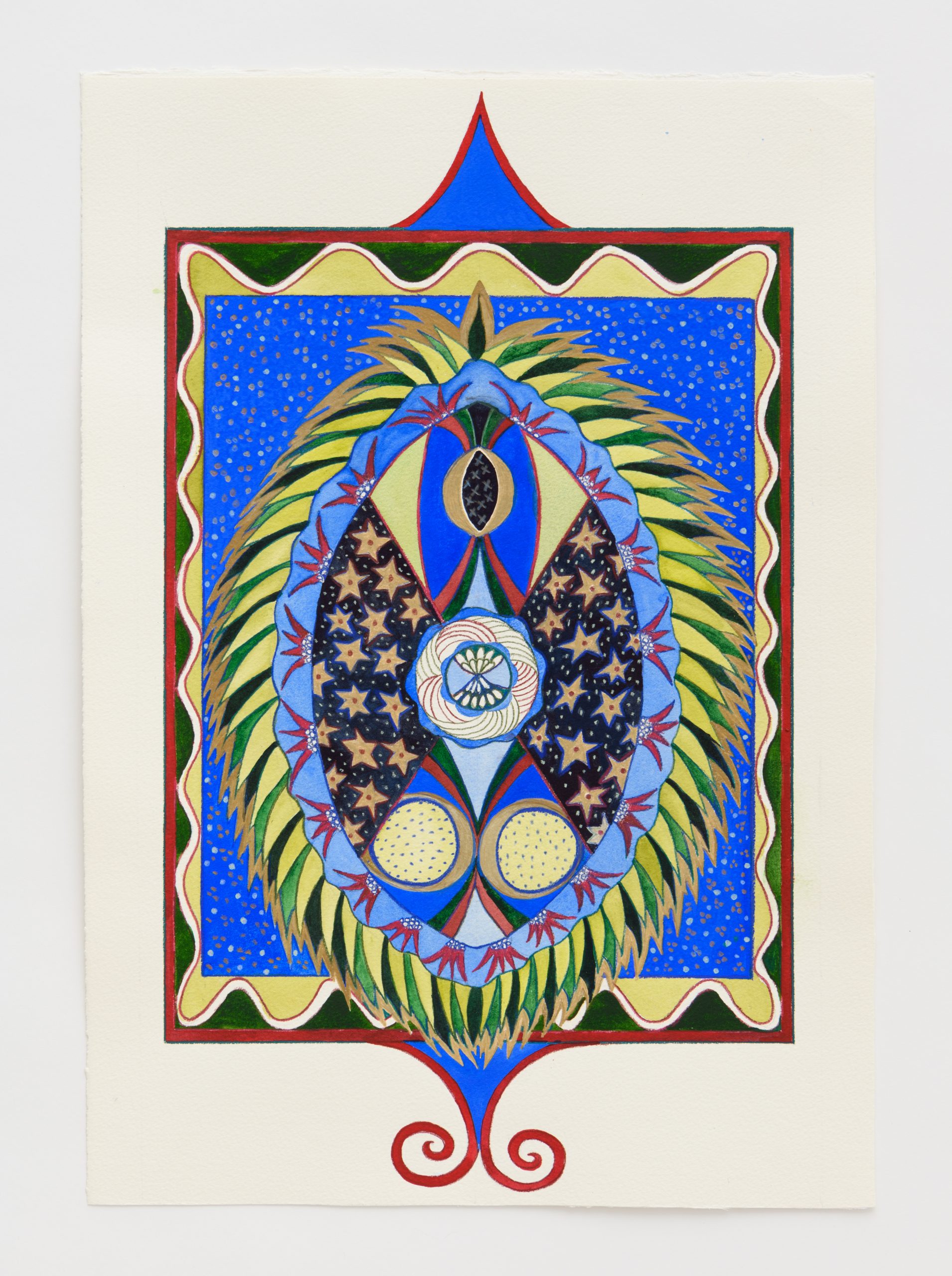
Anat Ebgi gallery (372 Broadway, New York City) presents a solo exhibition surveying over five decades of the career of pioneering eco-feminist artist Faith Wilding. The exhibition, “Inside, outside, alive in the shell (1972 to Present),” January 17 through March 1, 2025, will illuminate Wilding’s rich visual vocabulary comprising shells, eggs, the cocoon or chrysalis, mermaids, “dress,” particularly armor, blood, winged insects, and various plant forms including seeds, flowers, buds, stems, branches, and leaves. Lifecycles, openings, rebirth, emergence, growth, transformation, possibility, these are the philosophical themes and throughlines that Wilding’s iconography addresses.
The exhibition features painting, drawing, watercolor, collage, papier-mâché sculptures, papyrus scrolls, alongside ephemera including notes, sketches, slides, photographs, and performance documentation. Key bodies of work on view are Battle Dresses, works from her Scriptorium and Hildegard series, Rorschach Watercolors, alongside early and new (2024) works that comprise script and image. Together the works present a fuller picture of Wilding’s long explorations of the deterioration of the natural world, biopolitics, spiritual exuberance, and the strength of bare emotion.
Two recent solo presentations of her work in New York were narrow in their scope. Anat Ebgi’s booth at the Art Dealers Association of America “The Art Show” (2023) featured recent watercolor and gold leaf works alongside historic works from her Imago Femina series (1970s), and “Being like leaves” at Bortolami (2022), which focused on a juxtaposition between her Leaf Series (1976-78) of cut canvas oil paintings alongside her Fossils series of graphite drawings of decaying trees and botanicals. Prior to these presentations Wilding’s work hadn’t exhibited in New York since 1995.
This retrospective-style exhibition will be the first career-spanning exhibition in New York to trace developments in Wilding’s prolific output.
Many know her oft-cited performance and installation works created for Womanhouse (1972) while she was the graduate assistant in the Feminist Art Program at CalArts to Miriam Shapiro and Judy Chicago: Waiting, a 15-minute scripted monologue performance condensing a woman’s entire life into a monotonous, repetitive cycle of waiting for life to begin while she is serving and maintaining the lives of others, and Crocheted Environment, referred to popularly as “Womb Room,” a web-like fiber installation that now resides at the Institute for Contemporary Art / Boston, brought into the collection in 1995 by then Chief Curator, Helen Molesworth.
Over 50 years has passed since Wilding’s early years in California, this exhibition presents a fresh view of her vast and complex history
About Faith Wilding
Avowed eco-feminist Faith Wilding (b. 1943, Paraguay) has nurtured an art and activist practice to address the deterioration of the natural world, spiritual exuberance, and biopolitics. Renowned for her contributions to feminism and environmentalism, Wilding emerged at the forefront of Feminist Art in Los Angeles during the late 1960s and 1970s. Wilding was a co-initiator of the Feminist Art Program at CalArts alongside Miriam Shapiro and Judy Chicago. The Feminist Art Program produced Womanhouse in 1972, an art installation and performance space focusing on collaborative and feminist ideas. Wilding’s work continues to interrogate societal narratives, challenging the status quo in art-making, life, and politics
Wilding’s experience of growing up in a pacifist commune in Paraguay (as part of the Bruderhof Anabaptists) with little contact with the outside world had a tremendous impact on her. Ecstatic childhood experiences of wild nature, studying the South American jungle forests and waterways planted early seeds that would inform her work upon arriving to the U.S. at age 18. She quickly combined these experiences with her research into connections between women and nature, examining the ecological, in-spirited philosophies of ecofeminism.
Wilding’s methods and materials combine the rigor of scientific illustration with the fantastic imagery of illuminated manuscripts. Though her work is inextricably linked to plants and nature, she does not depict (or abstract) flowers like many of her art historical forebears. She instead digs into symmetrical dualities: up and down, in and out, open and closed, evoking mystical, personal, and esoteric narratives. Roots, branches, leaves, shells, sinuous forms, all serve as lyrical metaphors for regeneration, considering what it feels like to observe one’s own body and world, as it changes, evolves, withers away, and becomes something new. Both delicate and harsh, Wilding’s work explores the pivotal moment between private revelation and public manifestation.
Faith Wilding has exhibited extensively worldwide since the late 1960s. A 2014 retrospective of Wilding’s work, “Fearful Symmetries,” traveled to five venues across the United States (Rhodes College, Memphis, TN; 3 Walls, Chicago, IL; Pasadena Armory Art Center, CA; University of Houston, TX; and Carnegie Mellon University, Pittsburgh, PA). An accompanying monograph edited by Shannon R. Stratton and including excerpts from Wilding’s (unpublished) memoirs was published in 2018.
Wilding’s work was included in the seminal survey “WACK! Art and the Feminist Revolution,” organized by Cornelia Butler, which traveled from the Museum of Contemporary Art (Los Angeles) to the National Museum of Women (Washington DC), PS1 Contemporary Art Center (Long Island), and the Vancouver Art Gallery.
2022 marked the fiftieth anniversary of Womanhouse, an influential Los Angeles exhibition, installation, and performance space organized through the CalArts Feminist Art Program. At Womanhouse, Wilding’s Womb Room fiber installation and performance, Waiting, are some of the best known and highly influential works of the 1970s Feminist Art Movement. Wilding’s book By Our Own Hands, catalogs this important era of experimentation and collaboration that defined west coast Feminist art during the early 1970s.
This post was originally published on this site be sure to check out more of their content

